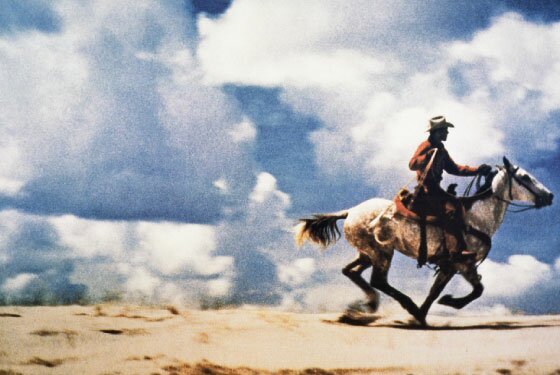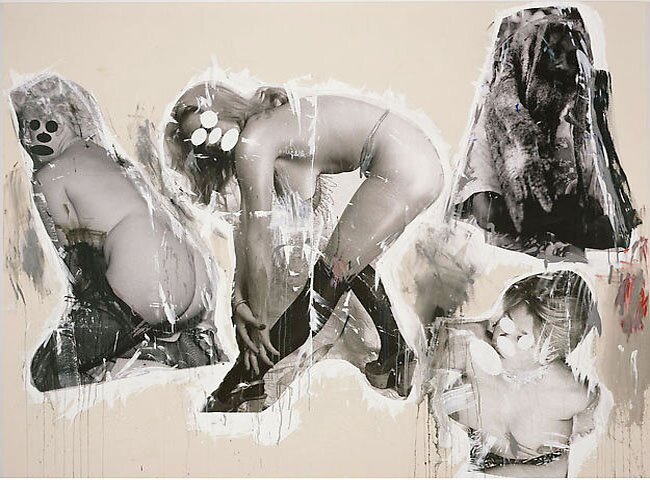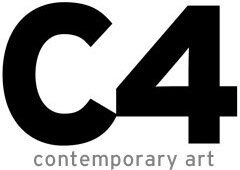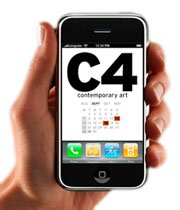|
Profile: Richard Prince
Affiliated Movements: Pop Art. Contemporary Art
Affiliated Artists:
Andy Warhol
Sherrie Levine
Hans Haacke
Robert Rauschenberg
Barbara Kruger
Jenny Holzer
* The placement of other artists in the same category is purely for didactic purposes - any number alternate criteria could result in a different choice. This list is chosen by suggesting other artists, mostly working at the same point in time and whose work might evoke similar questions in the viewer.
|
 |
The 'Marlboro Cowboy' Series

Untitled (cowboy) 1989
Ektacolor photograph
50 x 70 inches |
 Untitled (cowboy), 1980-86 Untitled (cowboy), 1980-86
Ektacolor photograph
40 x 27 inches |
 Untitled (cowboy) 1986 Untitled (cowboy) 1986
Ektacolor photograph
24x20 inches |
|
Commentary
Richard Prince achieved some notoriety following immediately on the heels of Sherrie Levine (who made the bigger waves first), known for her 'sacreligious' low quality reproductions of well-known photographs by Walker Evans.Richard prince became known early on for his appropriations of popular images used in commercial media (billboards, magazine advertising, etc.). And here lies the problem that people occasionally have with his work - in the culling of imagery from the high dollar advertising world, Prince is forcing people to reconsider an established system of values. It is in fact a full-on attack on commercialism and the apparatus which allows such messages to be transmitted to the gentry. But more than this, it is a request to the viewer that we question our open willingness to absorb this imagery in the way which it was intended. Prince was seen as the agent for the 'appropriation' vanguard of 1980, emboldening a whole generation of artists at this time. To what degree he can be considered a figurehead in this regard is impossible to say. A better argument can perhaps be made for his being an agent of Zeitgeist. Regardless, this tactic - appropriation - was really nothing new. It was in fact one of the key tools exploited by Andy Warhol in his explorations into media, conditioning and culture. And indeed, this is the very basis and power invested in the art of the collage, which goes much further back, especially interesting when one explores the work of the DaDa, John Heartfield and a host of others. What is in fact revelatory - what is new, about Richard Prince's work (as well as Levine's) is the removal of syntactical structures from the work - the cultural construct being presented is presented on it's own terms. Cocky, yes. Contentious, yes. Both Prince and Levine go one step further in removing the artist's hand from the equation through the simplest of manoeuvers. Recontextualization. While Levine's hand maybe a little more subtle,slippery or deft in the act - Prince's is simply 'naughty' in the knowledge that he would raise the hackles of pretty much anyone considering the 'work'.
Further to this end, in playing the 'bad boy' prince stirred the pot further with his series of magenta tinged poor-qualityektacolor machine-printed photographs of clouds, with sexist jokes superimposed on them. While such work seems highly predictable - perhaps it is most important in it's function as a cultural pressure valve of sorts – permitting the larger 'project' if you will, to continue. Similar themes resonate too in later work (see below).
|
|
Controversy
Some controversy had arisen at one point over the fact that the photographic source material WAS appropriated. Sam Abell, the original photographer hired to make the 'cowboy shots' has raised a lot of fuss over it. While I have made a certain case for the work not drawing it's interest from the same focus as the appropriated source material (which would be the legal arguing point), such 'moral' issues ar e rarely so black-and-white. What do you think? Is there ever a time when it is okay (or not okay) to 'borrow' original artwork in this manner?
This video interview with Sam Abell, the original photographer of the images in question indicates the inability of the 'establishment' to be able to process such a question in a meaningful manner. Or it could simply be that Abell is attempting to hijack the controversty in order to subvert the newfound cultural capital inherent in the resulting piece. What a crazy world!
|
|
Biography
Richard Prince achieved some notoriety following immediately on the heels of Sherrie Levine, known for her 'sacreligious' low quality reproductions of well-known photographs by Walker Evans. Prince was seen as the agent for the 'appropriation' vanguard of 1980, emboldening a whole generation of artists at this time. To what degree he can be considered a trailblazer is impossible to say. A better argument can perhaps be made for his being an agent of Zeitgeist. Regardless, this tactic - appropriation - was really nothing new. It was in fact one of the key tools exploited by Andy Warhol in his explorations into media, conditioning and culture. And indeed, this is the very basis and power invested in the art of the collage, which goes much further back, especially interesting when one explores the work of the DaDa, John Heartfield and a host of others. What is in fact revelatory - what is new, about Richard Prince's work (as well as Levine's) is the removal of syntactical structures from the work - the cultural construct being presented is presented on it's own terms. Cocky, yes. Contentious, yes. Both Prince and Levine go one step further in removing the artist's hand from the equation through the simplest of manoeuvers. Recontextualization. While Levine's hand maybe a little more subtle,slippery or deft in the act - Prince's is simply 'naughty' in the knowledge that he would raise the hackles of pretty much anyone considering the 'work'.
Further to this end, in playing the 'bad boy' prince stirred the pot further with his series of magenta tinged poor-qualityektacolor machine-printed photographs of clouds, with sexist jokes superimposed on them. While such work seems highly predictable - perhaps it is most important in it's function as a cultural pressure valve of sorts – permitting the larger 'project' if you will, to continue. Similar themes resonate too in later work (see below).
|
The Canal Zone Collages

Back to the Garden, 2008
Inkjet, acrylic and collage on canvas
80 x 120 inches (203.2 x 304.8 cm) |
 Pumpsie Green, 2008 Pumpsie Green, 2008
Inkjet, acrylic and collage on canvas
77 x 100 1/2 inches (195.6 x 255.3 cm) |
 Île de France, 2008 Île de France, 2008
Inkjet, acrylic and collage on canvas
77 1/4 x 100 1/2 inches (196.2 x 255.3 cm) |

Untitled (three women looking in the same direction), 1977
set of 4 Ektacolor photographs, 51x61 cm each |
| |
 Untitled (four women looking in the same direction), 1977 Untitled (four women looking in the same direction), 1977
set of 4 Ektacolor photographs, 51x61 cm each |

Untitled (three hands with watches) 1980
A set of three Ektacolor photographs
20 x 24 inches |
 Untitled (four women looking in the same direction), 1977 Untitled (four women looking in the same direction), 1977
set of 4 Ektacolor photographs, 51x61 cm each |
Other Media
written and edited by JWD
|
















